Right now, Abraham Lincoln is in Philadelphia with the rest of the U.S. government.Where Lincoln?
You are using an out of date browser. It may not display this or other websites correctly.
You should upgrade or use an alternative browser.
You should upgrade or use an alternative browser.
Stonewall Jackson's Way: An Alternate Confederacy Timeline
- Thread starter TheRockofChickamauga
- Start date
- Status
- Not open for further replies.
Threadmarks
View all 106 threadmarks
Reader mode
Reader mode
Recent threadmarks
Chapter Seventy-Nine: The Presidency of Charles E. Hughes Chapter Eighty: La Guerre est Finie, la Fin est Venue Chapter Eighty-One: The Mexican Presidential Election of 1917 Chapter Eighty-Two: The U.S. Presidential Election of 1920 Chapter Eighty-Three: The French Fallout Chapter Eighty-Four: Foch, France, and Fraternity? Chapter Eighty-Five: The World Responds Chapter Eight-Six: The CSA Presidential Election of 1921
Chapter Eight: The Sickles Conspiracy
Chapter Eight: The Sickles Conspiracy

General Daniel Sickles
With the fall of Washington, the failure of the Army of the Potomac to come to the city's rescue was highly critiziced by the U.S. government officials, now housed in the United States' temporary capital in Philadelphia. Calls for Sykes' relief were heard through out Congress, and one of Sykes' subordinates, Daniel Sickles, was all to happy to cooperate. Sickles had wanted command of the Army of the Potomac ever since Gettysburg, and expected it since he was the Army of the Potomac's senior officer following Gettysburg. Sykes' promotion to the job brought him great dissatisfaction, and it likely started Sickles' conspiracy against him. Sickles would first try to find allies among the officer corps of the Army of the Potomac. Sickles would find it in five officers. They were Alfred Pleasonton, Albion Howe, Daniel Butterfield, Hugh Kilpatrick, and John Cadwell. Sickles brought Howe to his side by promising him that he could retain his current command of the VI Corps, which he had received following Couch's resignation from it in disgust following Washington's fall. This was of great importance for Howe, as it seemed that Charles Schurz, his senior in rank, might be given the post. True to his word, Sickles ensured Howe maintained the command. Sickles' promise to Butterfield that upon his rise to command of the army, he would give his command of the III Corps to him, a post Butterfield had held at Fredericksburg before Hooker assigned him as his chief-of-staff. Sickles brought Cadwell into his fold by promising to see to it that the charges of cowardice pressed against him for his actions at Gettysburg would be dropped. Finally, Sickles promised Pleasonton and Kilpatrick something they could not resist, a backdating of their promotions. It seemed that Sickles failed to sway only one officer he tried to bring to his side, George Custer. Promising him the position of chief-of-staff of the Army of the Potomac, Custer would decline the offer, perfectly satisfied in his current post as a division commander of cavalry. 
General Daniel Sickles





The other members of the Sickles' conspiracy: Alfred Pleasonton, Albion Howe, Daniel Butterfield, Hugh Kilpatrick, and John Cadwell
Last edited:
something bad is about to happen here
I know. It starts with a "C" and rhymes with "Poo".
I feel that their will be one or two more battles and then peace negotiations will start.
Chapter Nine: The Union Assault on Washington
Chapter Nine: The Union Assault on Washington

A painting of Michael Corcoran leading his old command, the 69th New York, in a charge during the final stages of the battle by Matthew Kunstler
With the newly reformed Army of the Potomac under his command, Sickles felt confident in his ability to recapture Washington. However, his plans for what he would do following its recapture were quite different then that of the government he was serving. In a recently discovered letter to his wife, it was revealed that Sickles planned to declare himself the President of the United States following Washington's capture. This helps explain his decision to leave the XIII Corps under Edward O.C. Ord, which was his best and strongest corps, in Philadelphia, which he likely planned on using to seize the current U.S. government. The amount of this that his subordinates, or even his former allies in the conspiracy against Sykes knew about this was almost certainly none. With his ambitions dependent on the capture of Washington, Sickles would move out.
A painting of Michael Corcoran leading his old command, the 69th New York, in a charge during the final stages of the battle by Matthew Kunstler
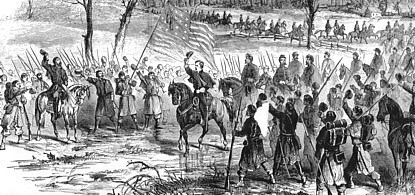
Sickles at the head of his army preparing to move out

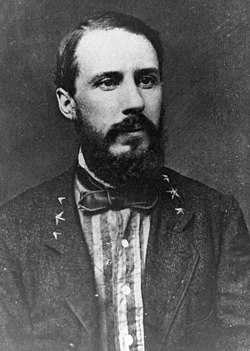
Richard S. Ewell and Edward P. Alexander

A Kevin Rocco painting depicting the decimated remnants of the 6th Wisconsin, now in the III Corps, charging into action into action in front of Gettysburg
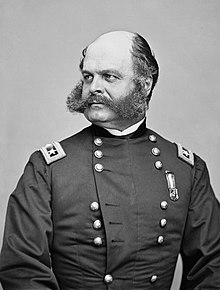
General Ambrose Burnside: 1824-1863


Michael Corcoran and Marsena Patrick
A painting of the 1st Minnesota in their last charge
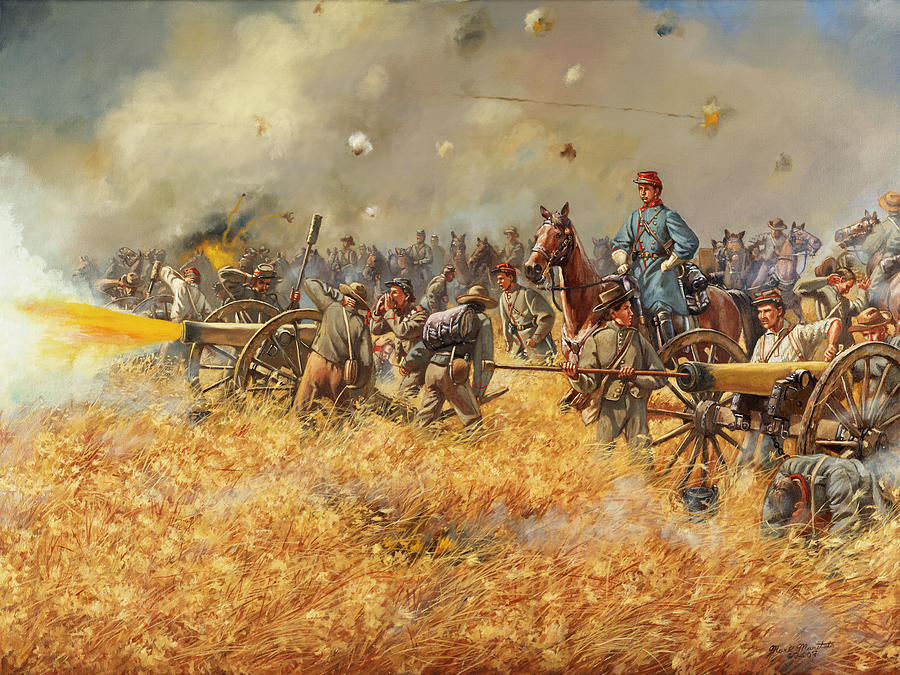
A painting of Confederate artillery at Washington under the command of Major Joseph W. Latimer
The Union assault on Washington forever destroyed Union hopes in the Eastern Theater. Now the only hope of victory for the Union lay in the Western Theater, and particularly upon the sucessful execution of a campaign by William S. Rosecrans and the Army of the Cumberland.
[1]: The officers Alexander listed with this comment are as follows: E.P. Alexander, James B. Walton, J. Thompson Brown, Reuben L. Walker, Stapleton Crutchfield, Stephen D. Lee, Peyton Manning, Robert M. Stribling, Joseph Latimer, William R. J. Pegram, Richard S. Andrews, Robert A. Hardway, James Dearing, John T. Brown, Willis J. Dance, William T. Poague, Hilary P. Jones, Frank Huger, and Henry H. Carlton.
Last edited:
US and CSA Order of Battles for the Union Assault on Washington
Union
Army of the Potomac
MG Daniel Sickles Commanding
III Corps: MG Daniel Butterfield
1st Division: BG James B. Ricketts
2nd Division: BG John C. Cadwell
3rd Division: BG Gouverneur Warren
VI Corps: MG Albion M. Howe
1st Division: BG James Barnes
2nd Division: BG Charles Griffin
3rd Division: MG Carl Schurz
IV Corps: MG John G. Parke
1st Division: BG Thomas Welsh
2nd Division: BG Robert B. Potter
XXI Corps: MG Thomas L. Crittenden
1st Division: BG Thomas J. Wood
2nd Division: MG John M. Palmer
3rd Division: BG Horatio P. Van Cleve
XXIII Corps: MG Ambrose Burnside
1st Division: BG Julius White
2nd Division: BG Milo S. Hascall
Cavarly Corps: MG Alfred Pleasonton
1st Division: BG Hugh J. Kilpatrick
2nd Division: BG George A. Custer
3rd Division: BG Julius Stahel
Detached 2nd Division from X Corps: BG Truman Seymour
Detached 1st Division from VII Corps: BG Michael Corcoran
Confederate
Army of Northern Virginia
Gen. Robert E. Lee Commanding
Chief of Staff: Robert Chilton
Chief of Artillery: Edward P. Alexander
Medical Director: Lafayette Guild
Military Secretary: Armistead L. Long
Aide-de-camps: Walter Taylor, Charles Marshall, Charles Venable
I Corps: LTG George H. Thomas
Anderson's Division: MG Richard Anderson
Wilcox's Brigade: BG Cadmus Wilcox
Mahone's Brigade: BG William Mahone
Wright's Brigade: BG Ambrose Wright
Lang's Brigade: Col. David Lang
Posey's Brigade: BG Carnot Posey
Johnson's Division: MG Edward Johnson
Kershaw's Brigade: BG Joseph B. Kershaw
Barksdale's Brigade: BG William Barksdale
Semmes' Brigade: BG Paul J. Semmes
Wofford's Brigade: BG William T. Wofford
McLaws' Brigade: BG Lafayette McLaws
Pender's Division: MG William D. Pender
Garnett's Brigade: BG Richard B. Garnett
Kemper's Brigade: BG James L. Kemper
Armistead's Brigade: BG Lewis A. Armistead
Pickett's Brigade: BG George E. Pickett
Jenkins' Brigade: BG Micah Jenkins
Corse's Brigade: BG Montgomery Corse
Artillery Reserve: Col. James B. Walton
II Corps: LTG Thomas J. "Stonewall" Jackson
Hill's "Light" Division: MG A.P. Hill
McGowan's Brigade: BG Samuel McGowan
Lane's Brigade: BG James H. Lane
Thomas' Brigade: BG Edward L. Thomas
Scales' Brigade: BG Alfred M. Scales
Early's Division: MG Jubal Early
Hays' Brigade: Col. Leroy Stafford
Smith's Brigade: Col. James B. Terrill
Hoke's Brigade: BG Robert F. Hoke
Gordon's Brigade: BG John B. Gordon
Rodes' "Stonewall" Division: MG Robert E. Rodes
Steuart's Brigade: BG George H. Steuart
Walker's "Stonewall" Brigade: BG James A. Walker
Nicholls' Brigade: BG Francis R.T. Nicholls
Jones' Brigade: BG John M. Jones
Artillery Reserve: Col. J. Thompson Brown
III Corps: LTG James Longstreet
Hill's Division: MG D.H. Hill
Daniel's Brigade: BG Julius Daniel
Doles' Brigade: BG George P. Doles
Iverson's Brigade: Col. Bryan Grimes
Ramseur's Brigade: BG Stephen D. Ramseur
O'Neal's Brigade: Col. Cullen A. Battle
Hood's Division: MG John B. Hood
Law's Brigade: Col. William C. Oates
Robertson's "Texas" Brigade: Col. Van. H. Manning
Anderson's Brigade: BG George T. Anderson
Benning's Brigade: BG Henry L. Benning
Trimble's Division: MG Isaac Trimble
Pettigrew's Brigade: BG James J. Pettigrew
Heth's Brigade: BG Henry Heth
Archer's Brigade: BG James J. Archer
Davis' Brigade: Col. Benjamin Humphreys
Artillery Reserve: Col. Reuben L. Walker
Cavalry Corps: MG J.E.B. Stuart
Hampton's Brigade: BG Wade Hampton III
Robertson's Brigade: Col. Laurence S. Baker
Fitz Lee's Brigade: BG Fitzhugh Lee
Jenkins' Brigade: BG Albert Jenkins
Rooney Lee's Brigade: BG William H.F. Lee
Jones' Brigade: BG William E. Jones
Stuart's Horse Artillery: Col. John Pelham
Imboden's Command (attached): BG John Imboden
Morgan's Command (attached): BG John H. Morgan
Williams' Command (attached): BG John S. Williams
Davidson's Command (attached): BG Henry B. Davidson
Provisional Corps: LTG Richard S. Ewell
Jones' Division: MG David R. Jones
McCausland's Brigade: BG John McCausland
Echols' Brigade: BG John Echols
Wharton's Brigade: BG Gabriel Wharton
Patton's Brigade: Col. George S. Patton
Ransom's Division: MG Robert Ransom
Ransom's Brigade: BG Matt Ransom
Cooke's Brigade: BG John R. Cooke
Lee's Brigade: Col. Edwin T. Lee
Johnson's Brigade: Col. Bradley T. Johnson
Elzey's Brigade: MG Arnold Elzey
Taliaferro's Brigade: BG William B. Taliaferro
Hagood's Brigade: BG Johnson Hagood
Wallace's Brigade: Col. William H. Wallace
Elliot's Brigade: Col. Stephen Elliott
Army of the Potomac
MG Daniel Sickles Commanding
III Corps: MG Daniel Butterfield
1st Division: BG James B. Ricketts
2nd Division: BG John C. Cadwell
3rd Division: BG Gouverneur Warren
VI Corps: MG Albion M. Howe
1st Division: BG James Barnes
2nd Division: BG Charles Griffin
3rd Division: MG Carl Schurz
IV Corps: MG John G. Parke
1st Division: BG Thomas Welsh
2nd Division: BG Robert B. Potter
XXI Corps: MG Thomas L. Crittenden
1st Division: BG Thomas J. Wood
2nd Division: MG John M. Palmer
3rd Division: BG Horatio P. Van Cleve
XXIII Corps: MG Ambrose Burnside
1st Division: BG Julius White
2nd Division: BG Milo S. Hascall
Cavarly Corps: MG Alfred Pleasonton
1st Division: BG Hugh J. Kilpatrick
2nd Division: BG George A. Custer
3rd Division: BG Julius Stahel
Detached 2nd Division from X Corps: BG Truman Seymour
Detached 1st Division from VII Corps: BG Michael Corcoran
Confederate
Army of Northern Virginia
Gen. Robert E. Lee Commanding
Chief of Staff: Robert Chilton
Chief of Artillery: Edward P. Alexander
Medical Director: Lafayette Guild
Military Secretary: Armistead L. Long
Aide-de-camps: Walter Taylor, Charles Marshall, Charles Venable
I Corps: LTG George H. Thomas
Anderson's Division: MG Richard Anderson
Wilcox's Brigade: BG Cadmus Wilcox
Mahone's Brigade: BG William Mahone
Wright's Brigade: BG Ambrose Wright
Lang's Brigade: Col. David Lang
Posey's Brigade: BG Carnot Posey
Johnson's Division: MG Edward Johnson
Kershaw's Brigade: BG Joseph B. Kershaw
Barksdale's Brigade: BG William Barksdale
Semmes' Brigade: BG Paul J. Semmes
Wofford's Brigade: BG William T. Wofford
McLaws' Brigade: BG Lafayette McLaws
Pender's Division: MG William D. Pender
Garnett's Brigade: BG Richard B. Garnett
Kemper's Brigade: BG James L. Kemper
Armistead's Brigade: BG Lewis A. Armistead
Pickett's Brigade: BG George E. Pickett
Jenkins' Brigade: BG Micah Jenkins
Corse's Brigade: BG Montgomery Corse
Artillery Reserve: Col. James B. Walton
II Corps: LTG Thomas J. "Stonewall" Jackson
Hill's "Light" Division: MG A.P. Hill
McGowan's Brigade: BG Samuel McGowan
Lane's Brigade: BG James H. Lane
Thomas' Brigade: BG Edward L. Thomas
Scales' Brigade: BG Alfred M. Scales
Early's Division: MG Jubal Early
Hays' Brigade: Col. Leroy Stafford
Smith's Brigade: Col. James B. Terrill
Hoke's Brigade: BG Robert F. Hoke
Gordon's Brigade: BG John B. Gordon
Rodes' "Stonewall" Division: MG Robert E. Rodes
Steuart's Brigade: BG George H. Steuart
Walker's "Stonewall" Brigade: BG James A. Walker
Nicholls' Brigade: BG Francis R.T. Nicholls
Jones' Brigade: BG John M. Jones
Artillery Reserve: Col. J. Thompson Brown
III Corps: LTG James Longstreet
Hill's Division: MG D.H. Hill
Daniel's Brigade: BG Julius Daniel
Doles' Brigade: BG George P. Doles
Iverson's Brigade: Col. Bryan Grimes
Ramseur's Brigade: BG Stephen D. Ramseur
O'Neal's Brigade: Col. Cullen A. Battle
Hood's Division: MG John B. Hood
Law's Brigade: Col. William C. Oates
Robertson's "Texas" Brigade: Col. Van. H. Manning
Anderson's Brigade: BG George T. Anderson
Benning's Brigade: BG Henry L. Benning
Trimble's Division: MG Isaac Trimble
Pettigrew's Brigade: BG James J. Pettigrew
Heth's Brigade: BG Henry Heth
Archer's Brigade: BG James J. Archer
Davis' Brigade: Col. Benjamin Humphreys
Artillery Reserve: Col. Reuben L. Walker
Cavalry Corps: MG J.E.B. Stuart
Hampton's Brigade: BG Wade Hampton III
Robertson's Brigade: Col. Laurence S. Baker
Fitz Lee's Brigade: BG Fitzhugh Lee
Jenkins' Brigade: BG Albert Jenkins
Rooney Lee's Brigade: BG William H.F. Lee
Jones' Brigade: BG William E. Jones
Stuart's Horse Artillery: Col. John Pelham
Imboden's Command (attached): BG John Imboden
Morgan's Command (attached): BG John H. Morgan
Williams' Command (attached): BG John S. Williams
Davidson's Command (attached): BG Henry B. Davidson
Provisional Corps: LTG Richard S. Ewell
Jones' Division: MG David R. Jones
McCausland's Brigade: BG John McCausland
Echols' Brigade: BG John Echols
Wharton's Brigade: BG Gabriel Wharton
Patton's Brigade: Col. George S. Patton
Ransom's Division: MG Robert Ransom
Ransom's Brigade: BG Matt Ransom
Cooke's Brigade: BG John R. Cooke
Lee's Brigade: Col. Edwin T. Lee
Johnson's Brigade: Col. Bradley T. Johnson
Elzey's Brigade: MG Arnold Elzey
Taliaferro's Brigade: BG William B. Taliaferro
Hagood's Brigade: BG Johnson Hagood
Wallace's Brigade: Col. William H. Wallace
Elliot's Brigade: Col. Stephen Elliott
Last edited:
GreenSword
Banned
After a slaughter and defeat like that at Washington, the Union is done. Realistically, recognition from the UK and France for the CSA should be incoming soon. Pro-peace Northern Democrats will be screaming to high heaven about a "pointless war and slaughter to keep a people who no longer wish to be in the Union". The Western Theater is largely irrelevant at this point, I think.
SpaceOrbisGaming
Banned
After a slaughter and defeat like that at Washington, the Union is done. Realistically, recognition from the UK and France for the CSA should be incoming soon. Pro-peace Northern Democrats will be screaming to high heaven about a "pointless war and slaughter to keep a people who no longer wish to be in the Union". The Western Theater is largely irrelevant at this point, I think.
I couldn't agree more. At this point, the war is all but over. DC is in the hands of the CSA and European recognition should be incoming if not already accepted. I just don't see much point to the Western Theater. Even if they can win the capital of the United States is now occupied by a foreign power and any army nearby is now scattered to the four winds. The war is over. All that needs to be done is for the terms of surrender to be negotiated which at this point should be very much in the Confederate side. England or some other power will see to that.
GreenSword
Banned
I couldn't agree more. At this point, the war is all but over. DC is in the hands of the CSA and European recognition should be incoming if not already accepted. I just don't see much point to the Western Theater. Even if they can win the capital of the United States is now occupied by a foreign power and any army nearby is now scattered to the four winds. The war is over. All that needs to be done is for the terms of surrender to be negotiated which at this point should be very much in the Confederate side. England or some other power will see to that.
I wouldn't so much call it "terms of surrender" as I would terms of peace. The CSA would help its case by asking for only what is reasonable.
1)recognition of the seceded states as a sovereign nation
2)CSA recognizes West Virginia as part of the Union
3)referendum in Indian Territory (OTL Oklahoma) on whether to become a territory of the CSA or remain a territory of the Union
4)referendum in New Mexico territory on the same question
5)end to all hostilities (blockade,etc), repatriation of all prisoners, no reparations from either side for damages
I wouldn't so much call it "terms of surrender" as I would terms of peace. The CSA would help its case by asking for only what is reasonable.
1)recognition of the seceded states as a sovereign nation
2)CSA recognizes West Virginia as part of the Union
3)referendum in Indian Territory (OTL Oklahoma) on whether to become a territory of the CSA or remain a territory of the Union
4)referendum in New Mexico territory on the same question
5)end to all hostilities (blockade,etc), repatriation of all prisoners, no reparations from either side for damages
Even this peace is contentious. What of the southern counties of West Virginia where Confederate sympathies are incredibly high? What of Kentucky, Missouri and maybe even Maryland?
Chapter Ten: The Battle of Chickamauga Part One
Chapter Ten: The Battle of Chickamauga Part One

A painting depicting General Benjamin H. Helm leading his division at Chickamauga
The event that would set the Battle of Chickamauga into motion would be the Tullahoma Campaign. Starting June 24, 1863, Union General William S. Rosecrans would finally be convinced to move his Army of the Cumberland out from their fortifications in Murfressboro, Tennessee, and advance on to Chattanooga. Standing between Rosecrans and Chattanooga, however, would be General Braxton Bragg and the Army of Tennessee. Unfortunately for Rosecrans, Bragg occupied some of the best defensive territory in the Confederacy, making a successful offensive campaign seem nigh on impossible. Rosecrans, however, would continue with his goal, and the result would be the Tullahoma Campaign, in which Rosecrans pushed Bragg out of both Chattanooga and Tennessee by July 3 in some of the most brilliant maneuvering of the war. 
A painting depicting General Benjamin H. Helm leading his division at Chickamauga

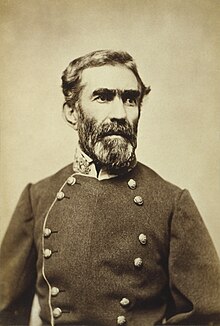
General William Rosecrans, a map of the Tullahoma Campaign, and General Braxton Bragg

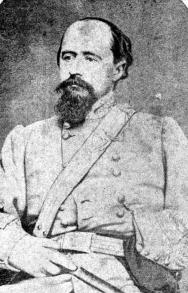
Generals Thomas Crittenden and William Loring


Wing Commanders Leonidas Polk and William J. Hardee
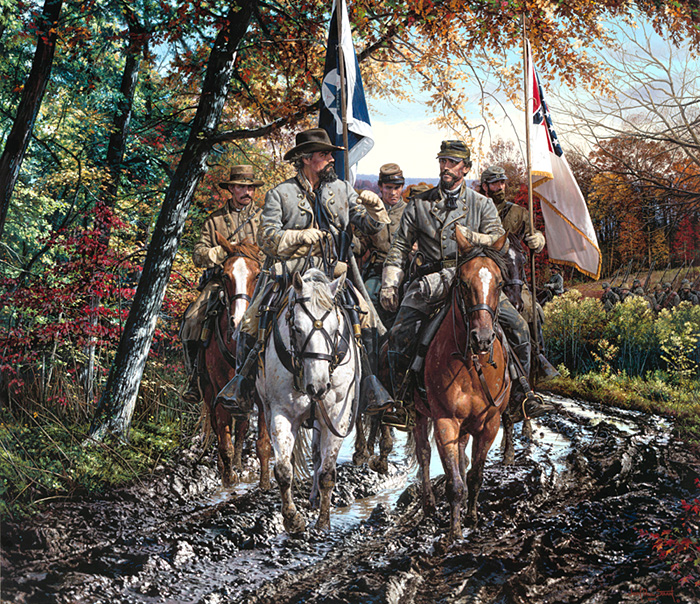
Generals Nathan B. Forrest and Patrick Cleburne at the head of Polk's wing
Last edited:
The Battle of Chickamauga started August 16 in this timeline, with the main battle (which will be described in the part two) happening on August 17. The battle's date has been moved up because of more pressure from Lincoln on Rosecrans to win a victory to attempt to stop foreign recognition of the CSA. For your second question, Rosecrans was moving his corps independently similar to OTL, and rushed them to Wilder's support, turning Chickamauga from a skirmish to a full-fledged battle in this timeline.Is ATL Chickamauga happening in mid September like OTL?
Was Rosecrans attempting to maneuver his Corps independently to flank Bragg like OTL and scrambled to make a stand a Chickamauga or is this a planned defensive location that he moved to directly from Chattanooga?
Chapter Eleven: The Battle of Chickamauga Part Two
Chapter Eleven: The Battle of Chickamauga Part Two

A painting of Cleburne at Chickamauga by Daniel Troiani
When the head of Polk's assault column arrived at the Union right, they were relieved to find it unprepared for action, as they were focused on one of Hardee's attack, which had been going on since the sun's rise. Similar to Jackson's attack at Chancellorsville, Polk's wing took McCook completely by surprise, and the right flank of the Army of the Cumberland would be completely shattered, with McCook's corps being thrown into a total rout. Meanwhile, Bragg, who was with Hardee's wing, heard of the success of Polk's attack. Knowing that all that was needed now for the Army of the Cumberland to shatter was for Negley's corps to break, Bragg ordered for Hardee's wing to attack Negley's corps one last time, with this time Bragg personally riding forward with his men into action. The decision would prove to be his undoing, as two Union musket shots would lodge themselves into Bragg's stomach. Being carried from the field, Bragg would turn over command of the Army of Tennessee to Leonidas Polk. A painting of Cleburne at Chickamauga by Daniel Troiani

An image depicting the advance of Hardee's wing on Negley's corps
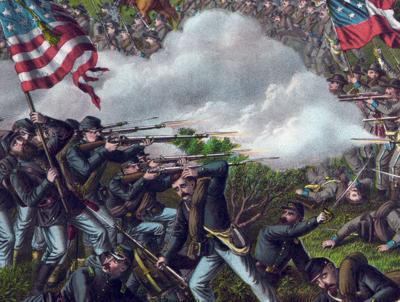

A detail form a Kurz & Allison lithograph of Granger's stand and a photograph of Gordon Granger
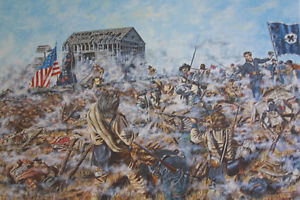
A painting of Cleburne's division storming into Chattanooga

A Daniel Troiani painting depicting Opdycke moments before his death.
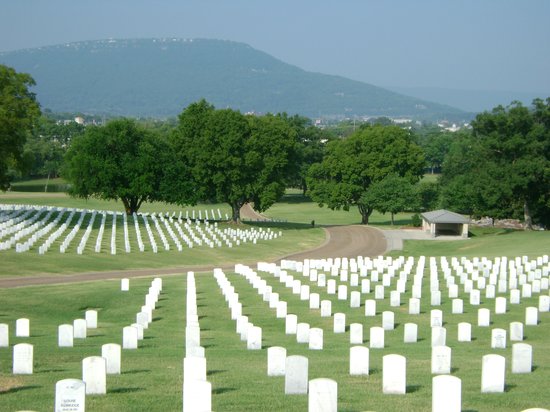
A picture of Chattanooga National Cemetery
Last edited:
Threadmarks
View all 106 threadmarks
Reader mode
Reader mode
Recent threadmarks
Chapter Seventy-Nine: The Presidency of Charles E. Hughes Chapter Eighty: La Guerre est Finie, la Fin est Venue Chapter Eighty-One: The Mexican Presidential Election of 1917 Chapter Eighty-Two: The U.S. Presidential Election of 1920 Chapter Eighty-Three: The French Fallout Chapter Eighty-Four: Foch, France, and Fraternity? Chapter Eighty-Five: The World Responds Chapter Eight-Six: The CSA Presidential Election of 1921- Status
- Not open for further replies.
Share: